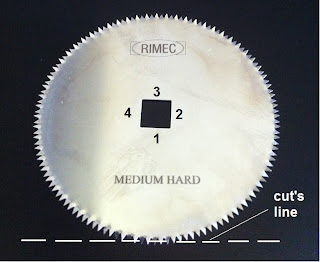How to limit
injuries during plaster cast removal
with HAL3000
Plaster cast removal is made, since years, by oscillating plaster saws, devices which facilitate the remotion of the plaster, accelerating all the removal procedure. In spite of a standard electric saw, a plaster saw runs with an oscillating movement which is studied in order to remove the plaster without hurt the skin.
Rimec plays an important part in plaster cast treatment... with HAL3000.
HAL3000 can operates both with normal and synthetic plaster; this flexibility is granted by two different types of blades, the "normal" and "extra-hard" 's ones, which firstly guarantee to avoid the problem of blade's temperature (which increases with the friction).
In any case, it might happens skin injuries: when the plaster cast is going to be removed, an eccessive pressure on the skin can cause wounds for the patient, who will not collaborate with the doctor.
In this way, HAL3000 came to solve the problem of skin wounds through an improvement of the oscillations up to 15.000/ minute, which help to cut only solid material and not the soft's one, which follow the movement because it's adapted.
Normally, others plaster saws present on the market have between 11.000 and 16.000 oscillations; following Rimec's studies, is it possible to affirm that the threshold of 15.000 oscillations it is good in order to leave uninjured the skin under the plaster cast.
Following this point, Rimec has also designed HAL3000 in order to take care about:
- blade's temperature;
- layers of cast padding;
- skin conditions;
The temperature of the blade can be monitored in two ways:
1) using the blade with reference to the type of plaster (normal blade or extra-hard blade) (see picture 1);
2) using the blade in all it sides (see picture 2) and cutting the plaster cast following perpendicular incision (see picture 3);
 |
| Blades for normal plaster cast (MEDIUM HARD) |
 |
| Blades for syntheticplaster cast (EXTRA HARD) |
Picture 1
 |
| With reference to the initial cut's line, the operator should change the side of the blade, blocking and moving it in the others points ( 1 is the first point, 2 - 3 - 4 are the others) |
Picture 2
 |
| The correct handhold of Hal3000 |
 |
| The cut have to follow a perpendicular line with reference to the plaster cast |
Picture 3
The layers of cast padding can be positioned between the plaster cast and the skin, in order to permit the blade to follow only solid materials.
About this purpose, Rimec always suggest to place some bandages with the aim to protect the skin.
Skin conditions have to be cared in regard, especially thinking about the risk of wound. About this point, the doctor will choose the best type of plaster for the patient, also with reference to contingent allergies of him.

Nessun commento:
Posta un commento